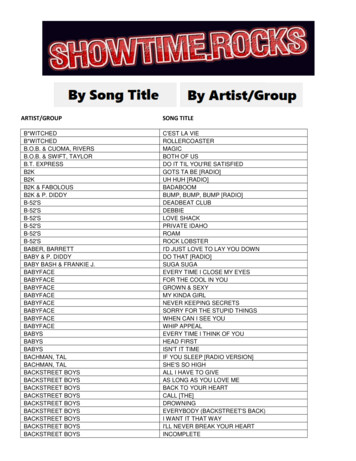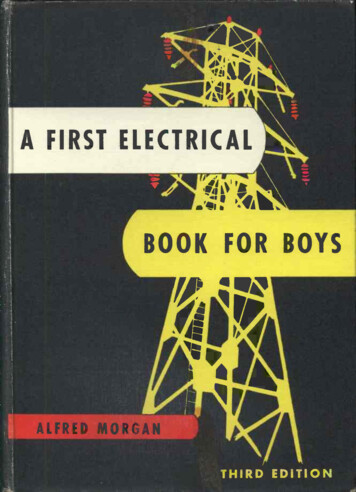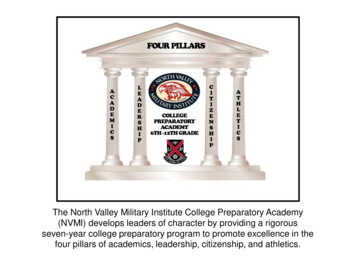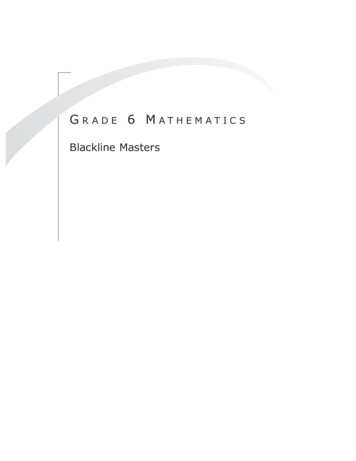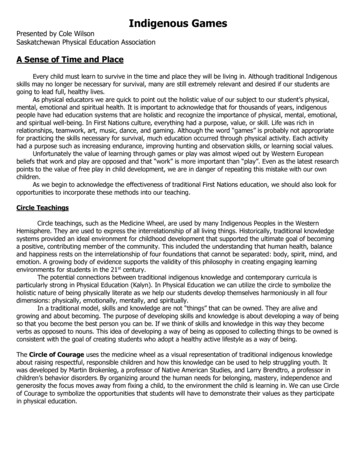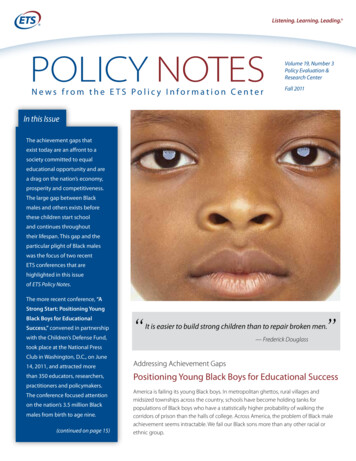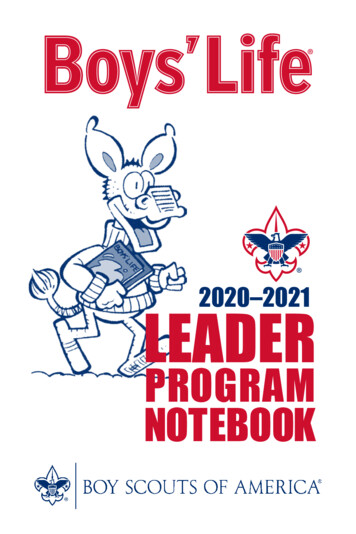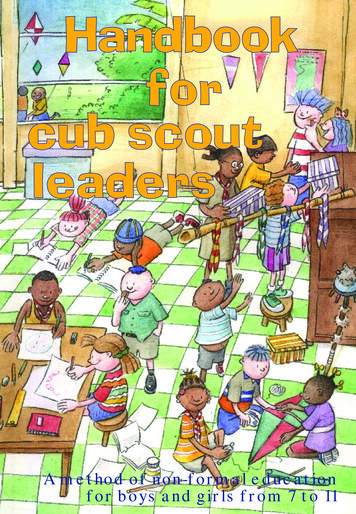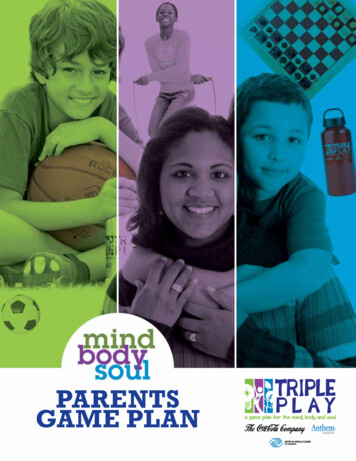
Transcription
PARENTSGAME PLAN
FOREWORDSmart nutritional choices, active lifestyles and self confidence are integral to helping youth reach their fullpotential. Unfortunately, many of today’s young people lack the tools and resources needed to learn the basics ofhealthy lifestyles and the importance of developing a positive self image.At Boys & Girls Clubs of America (BGCA), we know that helping young people to live healthier lifestyles gives thema better chance of improving their overall well-being. By providing our members with information about makingbalanced nutritional choices, leading active lives and increasing self-esteem, Clubs can make a positive change in thelives of our youth. Programs like BGCA’s Triple Play: A Game Plan for the Mind, Body and Soul program have beenproven to make a positive difference in the lives of our members.Triple Play, BGCA’s first comprehensive health and wellness program, strives to improve the overall health of members, ages6-18, by increasing their daily physical activity, teaching them good nutritional habits and helping them develop healthyrelationships. More than one million Club members have participated in Triple Play since its introduction in 2005.In a study conducted by Youth Development Strategies, Inc., researchers found that Triple Play: Helped youth meet the recommended physical activity standards by increasing the percentage of youth engagedin exercise for one hour or more at least five days a week;Increased activity among girls by two hours per week and decreased the percentage of youth who were relativelyinactive; andImproved members’ feelings of mastery and control over their lives.That’s why we partnered with our founding donor, The Coca-Cola Company, and our newest partner, AnthemFoundation, to launch Triple Play: A Game Plan for the Mind, Body and Soul. This program demonstrates how eatingsmart, keeping fit and forming positive relationships create healthy lifestyles for Club members.Parents and caregivers are critical to the success of the Triple Play initiative. By supporting your child’s athletic andother physical activity interests, you’re also creating opportunities to discuss important social issues that shapecharacter and build self esteem. Over time, this open dialogue can increase the chances of your child coming to youfor advice rather than turning to peers when faced with difficult situations.This new resource, Triple Play Parents Game Plan, features a sampling of the great program elements Triple Play: AGame Plan for the Mind, Body and Soul offers. This guide will help your family integrate key elements of Triple Playinto your daily lives. We thank you in advance for taking a proactive approach to health and wellness in your child’slife, and for supporting this project.Sincerely,Jim ClarkPresident & CEOBoys & Girls Clubs of AmericaFOREWORDBoys & Girls Clubs of America2Triple Play Parents Game Plan
TABLE OF CONTENTSINTRODUCTION4THE BENEFITS OF PARENTAL INVOLVEMENT5LEARNING TO MOTIVATE YOUR CHILD5HEALTHY HABITS7 Choose A Healthy PlateFocus on the Food EnvironmentEating Away From HomeFluids and HydrationPower SnackingFUN FITNESS ACTIVITIES 15Physical Activity Guidelines for AmericansWarm-ups and Cool-downsBasketball ChallengeGet Fit ChallengeHAVEFUN,INCREASE CONFIDENCESTRENGTHENRELATIONSHIPS,24 Importance of Social Recreation Character Building Skills DevelopmentRESOURCESTABLE OF CONTENTSBoys & Girls Clubs of America293Triple Play Parents Game Plan
INTRODUCTIONTRIPLE PLAY: A GAME PLAN FOR THE MIND, BODY AND SOULWelcome to Triple Play Parents Game Plan, a valuable resource guide to help you “get into the game” of health andfitness at home – where healthy habits start.Triple Play: A Game Plan for the Mind, Body and Soul is a dynamic initiative that demonstrates how eating smart,keeping fit and forming positive relationships add up to a healthy lifestyle. The Triple Play Parents Game Plan’s easyto-follow elements are designed to expand your health and wellness discussions with your child.As a parent, you play a critical role in the development of your child’s physical, mental and social well-being. TheTriple Play Parents Game Plan offers a holistic approach in three key areas:Mind:Developing a knowledge base to acquire healthy habits, such as making smart food choices, understanding appropriateportion sizes, and creating fun and healthy meals.Body:Becoming more physically active through daily fitness and fun, including activities to get kids active and moving.Soul:Strengthening character and reinforcing positive behavior with activities designed to improve confidence and developinterpersonal skills.Boys & Girls Clubs of America’s (BGCA) sponsors and partners, The Coca-Cola Company and Anthem Foundation, havecommitted their resources to launch Triple Play: A Game Plan for Mind, Body and Soul as well as to provide theParents Game Plan. Triple Play was named in fall of 2011 as a Program that Works by the Promising Practices Network (PPN) whichoffers research-based information to validate the effectiveness of programs that serve children and families.Additionally, the Triple Play program received a third-party longitudinal study involving 2,400 members ages 9-14.The results showed that the Triple Play program has a positive impact on participants. Specifically: Participation in Triple Play improves youth’s nutrition knowledge, particularly in the area of portion control. Triple Play benefits youth who already eat healthy, as well as those with unhealthy eating habits. Triple Play increases the amount of time youth spend engaged in physical activities and exercise.Triple Play Parents Game Plan is available free of charge n/triple-playINTRODUCTIONBoys & Girls Clubs of America4Triple Play Parents Game Plan
THE BENEFITS OF PARENTAL INVOLVEMENTBGCA recognizes that the time children spend in a Club is most effective when the messages they receive at theClub are reinforced by parents and caregivers. Studies show that youth programs have the most success whenparents, family members and youth development professionals partner to create a nurturing environment forchildren and teens.Parent and family involvement also contributes to a young person’s school achievement and healthy development.For example, youth whose parents are involved in their education and development are more likely to do wellin school, attend school regularly, graduate, have good social skills and continue to go to college. These youthalso are less likely to drop out of school, require special education, be arrested or require public assistance.Youth development professionals can foster parent involvement by encouraging parents and family members to: Attend school and Club activities and programs whenever possible.Talk to their child or teen about school activities and involvement at the Club.Communicate with Club staff to learn about ongoing programs and activities youth are involved in.Volunteer to be a tutor, mentor or coach for specific programs.Reinforce school and Club limits and guidelines consistently in their homes.Discuss school- and Club-related concerns their child or teen may have.Participate in family, school and Club activities whenever possible.Donate their time to chaperone school or Club field trips and outings.Recognize young people’s participation in activities and important milestones they’ve achieved.Attend school and Club award events.LEARNING TO MOTIVATE YOUR CHILDIt’s important to keep your child motivated while maintaining a fun and relaxed atmosphere. Become a mastermotivator who captivates, encourages and excites young people, and they’ll embrace what you have to say and carryit with them for the rest of their lives. Consider these tips for keeping youth motivated throughout the season: Keep skill level in mind: Remember that children of varying ages are at different developmental stageswhen it comes to coordination and fine motor skills. Be supportive: Let your child know she has done a great job, made a good try or improved her skills. Give your child a chance: Make sure the activities you select allow your child the opportunity to playand be involved. Consider timing: Be mindful of your child’s schedule, age and energy level when selecting and activity or sport. Allow for success: Make every activity one in which your child can achieve some level of success. Allow for mistakes: Be clear that making mistakes is a natural part of participating in athletic activities. Focus on fun and skill development: Motivation through fear or threats can be detrimental to a youngperson. Instead, let fun be the main motivator!INTRODUCTIONBoys & Girls Clubs of America5Triple Play Parents Game Plan
INTRODUCE GOAL SETTINGOne of the best ways to help your kids reach their goals is to have them write the goals down. After they are writtendown, be sure the goals are prominently displayed in your home so that your child can see them every day. Thisis a positive way of reinforcing what they want to achieve and reminding them to keep track of their progress.SET ATTAINABLE GOALSFor young people to reach goals, they must be clearly defined and fit the individual’s age, ability and level ofexperience with the sport. Attainable, or “SMART” goals should possess the following characteristics: SMART–––––Specific (clearly defined goals)Measureable (concrete criteria for measuring progress toward attainment)Attainable (within the availability of resources, knowledge and time)Relevant (within the availability of resources, knowledge and time)Time-bound (has a target date)QUICK TIP: BE A DREAM MAKER,NOT A DREAM STEALERSome young people dream about wearing an NBA uniformsomeday or suiting up to play in the NFL on Sundayafternoons. These are lofty goals, but that doesn’t meanyou shouldn’t support their efforts. Instead, while workingwith an athlete with professional sports aspirations, havehim set realistic goals and work on honing his skills. Byimproving his game, he’ll gain more satisfaction from thesport and be more inclined to stay involved with it. Andwho knows? He may just make it to the pros one day!INTRODUCTIONBoys & Girls Clubs of America6Triple Play Parents Game Plan
MIND: Healthy HabitsCHOOSE A HEALTHY PLATEThe United States Department of Agriculture’s new MyPlate graphic illustrates the five food groups that are the buildingblocks for a healthy diet using a familiar image—a place setting for a meal. MyPlate is part of a larger communicationinitiative based on 2010 Dietary Guidelines for Americans to help consumers make better food choices.ChooseMyPlate.gov features practical information and tips to help Americans build healthier diets. It featuresselected messages to help consumer focus on key behaviors. Selected messages include:BALANCING CALORIES Enjoy your food, but eat less.Avoid oversized portions.FOODS TO INCREASE Make half your plate fruits and vegetables.Make at least half your grains whole grains.Switch to fat-free or low-fat (1%) milk.Drink plenty of water.FOODS TO REDUCE Compare sodium in foods like soup, bread and frozen meal, and choose foods with lower numbers.ChooseMyPlate.gov includes much more consumer and professional information.MIND: Healthy HabitsBoys & Girls Clubs of America7Triple Play Parents Game Plan
GRAINS GROUPWhole grains such as whole wheat bread, oatmeal, some breakfast cereals, brown rice and popcorn should beincorporated into your family’s daily diet. Choose whole grains often. Foods like biscuits, sweet rolls, donuts,cookies and cake contain high amounts of fats and sugars, but usually few vitamins and minerals, and lessfiber. Eat these grains sparingly.VEGETABLES GROUPFoods from the vegetables group give us important nutrients we need for good health such as Vitamin A,Vitamin C, folate (a B vitamin), potassium and fiber. Vary your veggies! Eat more dark green veggies likebroccoli, spinach and kale, and orange ones like carrots and sweet potatoes. Choose dry beans and peas likekidney beans, black beans, split peas and lentils. These foods give are excellent sources of vitamins, mineralsand fiber.FRUITS GROUPFoods from the fruits group provide important nutrients needed for good health such as Vitamin C, folate (aB vitamin), potassium and fiber. Choose fruits of different colors. For example, you might have a green apple,yellow banana, red strawberries and purple grapes.GETTING MORE FRUITS, VEGETABLES AND GRAINS:AT BREAKFAST: Try a cereal with the words “whole grain” on the box and add a sliced banana.Have toast, a bagel or an English muffin with peanut butter on top.Put some raisins in your oatmeal.Drink a small glass of orange juice.AT LUNCH, DINNER OR SNACK TIME: Pack an apple, banana or orange for lunch.Order a fruit cup or bag of sliced apples when you go out for fast food.Put some dried apricots or a juice box in your kid’s backpack for an after school snack.Serve popcorn, baked tortilla chips or a bowl of cereal for snacks.Make a bowl of vegetable soup with lunch, dinner or for a snack.Offer carrot sticks, salad or a baked potato with a sandwich.Make a great big salad comprised of lots of different veggies for dinner.Provide an extra helping of veggies at dinner.Order pizza with extra veggies like tomatoes, peppers and mushrooms on top.Have carrot sticks, celery sticks or cherry tomatoes on hand for snacks.MIND: Healthy HabitsBoys & Girls Clubs of America8Triple Play Parents Game Plan
DAIRY GROUP Foods from the dairy group provide important nutrients such as calcium, potassium, vitamin D andprotein. To build strong bones and teeth, choose two – three cups (depending on your child’s age) of low-fatand fat-free milk products each day.Milk, yogurt and cheese are excellent foods to choose from the dairy group. It’s best to choose fat-free orlow-fat milk and yogurt, and low-fat cheese most often.MEAT AND BEANS GROUP Foods from the meat and beans group gives us protein (which helps build, repair and maintain our bodytissue), B vitamins (niacin, thiamin, riboflavin and B6), vitamin E, iron, zinc and magnesium.Eat foods like lean beef and pork, baked chicken without the skin, turkey without the skin, broiled or bakedfish, beans, peas, peanut butter and nuts. These foods supply vitamins, minerals and protein, without a lotof extra fat.NUTRITION DRAMATIC PLAYLet kids put their healthy eating habits into action. Set up a healthy restaurant area as the playsetting. A child-sized table and chairs and a play kitchen work well for the setting. Create menus thatinclude lots of healthy meal option. Have the kids take turns preparing and serving the customers atthe restaurant.A farmer’s market or store play area also fits the healthy eating theme. Arrange baskets and shelves ofhealthy play food. For inexpensive food, cut out food shapes from felt. Or, cut out two identical foodshapes. Sew them together and add stuffing to the middle. For a more structured play option, makeshopping lists and have the kids gather the items on the list and place them in a basket or shopping bag.A taste test encourages kids to try healthy foods. A blindfolded taste test adds a even moreexcitement and mystery to this activity. Cut up several different foods. An assortment of fruits andvegetables works well, especially if you include new produce the kids haven’t tried yet. The kids tryone item at a time to guess what it is. Another option is to make a few healthy recipes and have thekids try to figure out what ingredients are in the dish.HEALTHY FOOD PATTERNSThis nutrition game integrates the basic math concept of patterning. Cut out several healthy foodshapes. You want several of each shape. For example, you might cut out 15 each of apples, oranges,carrots, bananas and potatoes. Laminate the shapes to make them more durable for multiple uses.Create the beginning of a pattern and have the kids finish it. For example: banana, banana, apple,banana, banana, apple. The child would then continue that pattern. Once the kids get the hangof it, let them create their own patterns. Make it a partner activity by having one child start thepattern and the other finish it.MIND: Healthy HabitsBoys & Girls Clubs of AmericaTRY THIS AT HOMETASTE TEST9Triple Play Parents Game Plan
EATING AWAY FROM HOMEThe food we eat when we’re away from home often comes in larger portions and may be less healthful. It’s possibleto make healthy choices by watching portion sizes and avoiding foods with lots of fat, salt and sugar. Explain toyour child that it’s okay to have our favorites once in a while, but we need to balance them with nutritious mealsmost of the time.Introduce the idea of eating away from home by asking, “What do you know about eating healthy away fromhome? What do you want to know about eating healthy away from home?” then, ask your child how often heeats food when he’s away from home. Point out that most of us eat foods from convenience stores, cafeterias,vending machines and restaurants—especially fast food restaurants—on a regular basis.Explain that the meals and snacks we eat when we’re away from home: Are often served in larger portions than we needMay be higher in calories, fat, salt and sugar than food we eat at homeMay contain fewer of the nutrient-rich foods we need, like whole grains, milk, fruits and vegetablesPoint out that it is possible to make healthy choices when eating away from home by paying attention to somesimple guidelines: Watch portion sizes. Choose the smaller sizes and don’t “super-size” anything. Order a single-pattyburger instead of a double. Take home or share a serving with a friend.Avoid high-fat items. Anything that is deep-fried, pan-fried, basted, batter-dipped, breaded or crispy ishigh in calories, fats, and sodium. Choose grilled, broiled or steamed items, and order a baked potato inplace of French fries.“Undress” your food. Ask for sauces, spreads and salad dressings on the side and use only a small amount.Pay attention to beverages. Milk, 100 percent fruit juice and water are nutritious choices. If drinkingsoft-drinks, buy the 12-ounce size instead of the “super-sized” portion.Go for balance. If you want to eat a not-so-nutritious meal once in a while, balance it out by havingmore nutritious foods the rest of the week.Give examples of some healthier choices fast-food chains are offering: Chili (8-ounce serving)—270 calories, 5 grams fatGrilled chicken Caesar salad—200 calories, 6 grams fatGrilled chicken baguette—350 calories, 5 grams fatSub sandwiches—310 to 370 calories, 5 to 6 grams fatFruit and yogurt parfait—160 calories, 2 grams fatDiscuss the reasons it may not always be easy to make healthy choices when eating out. Point out that eventhough they may have favorites and are concerned they won’t like the healthy foods as much, it’s importantto try new things.MIND: Healthy HabitsBoys & Girls Clubs of America10Triple Play Parents Game Plan
Remind your family to look for these items when eating away from home.IN FAST FOOD RESTAURANTS, LOOK FOR: Green salads (with low-fat dressing)Fruit salads, fruit slices or fruit cupsSingle slice of veggie pizzaGrilled, not fried or breaded, sandwichesDeli sandwiches on whole-grain breadA small hamburgerA bean burritoA baked potatoFrozen yogurtYogurt shakes or parfaitsWhole wheat buns, tortilla or breadWater, orange or apple juice or low-calorie soft drinksSmaller sizes of sandwiches and french friesSandwiches without sauces, dressings or mayonnaiseIN THE SCHOOL CAFETERIA, LOOK FOR:Any fruit or vegetable (not fried), including tomato sauce or salsaSandwiches with lean meats or fish (like turkey, chicken or tuna)Raw baby carrots, green and red pepper strips, tomatoes or cucumbersSoups made with vegetables or beansBurritos made with beans and cheesePizza made with tomato sauce, cheese and veggiesWhole-grain breads, pita, bagels or crackersLow-fat or fat-free milk, yogurt,or cheesePopcornFrozen yogurtPeanut butterAT YOUR LOCAL CONVENIENCE STORE, LOOK FOR: Popcorn or pretzelsWhole-wheat crackersUnsalted nuts (peanuts, cashews, almonds)Cereal, especially whole grainLow-fat or fat-free milk or 100 percent fruit juiceDried or fresh fruitLow-fat or fat-free yogurtSmoothie drinksReduced-fat cheese sticksBottled water or low-calorie soft drinksMIND: Healthy HabitsBoys & Girls Clubs of AmericaTRY THIS AT HOME 11Triple Play Parents Game Plan
FLUIDS AND HYDRATIONFluids are extremely important for the body because they do many important jobs. Our bodies use up fluids wedrink so we have to replace them. This is called hydration. Kids should drink fluids before they become thirsty,and especially when they are exercising. Dehydration can cause fatigue, confusion and an inability to concentrate.Introduce your child to the importance hydration by asking, “What do you know about the importance of fluidsand the body? What do you want to know about the importance of fluids and the body?” Ask your child if heknows what the human body is made of. Point out that our bodies are about two-thirds water, and that wateris the main ingredient in all body fluids. Explain that fluids are necessary for every single body function. Infact, humans can live only about a week without fluids. Highlight some of the things fluids do: Help us digest our foodHelp us maintain healthy body temperaturesHelp our blood move around our bodiesCarry nutrients and oxygen to cells throughout our bodiesRemove toxins and other wastesKeep our joints from rubbing togetherProtect our tissues and organsPoint out that our bodies use up lots of fluids each day. We lose even more when we’re exercising or perspiring.Fluids come through the skin as sweat, which helps to cool down the skin and the blood. Explain that it is veryimportant to drink a lot of fluids so that our bodies have enough to function properly. We need to replace thefluids our bodies lose by drinking water and fluids every day. Dehydration occurs when you lose more fluidthan you take in, and your body doesn’t have enough water and other fluids to carry out its normal functions.POWER SNACKINGLike any other food, snacks contribute energy and nutrients to the total diet. “Power snacking” means eatingsnacks when you’re hungry and there’s a long time before the next meal, or when you need energy to keep yougoing. The recommendations for snack portion sizes are the same as those for meal portions, but what countsis the total amount consumed in a day.Introduce your child to the importance of “Power Snacking.” Remind your child that snacks, like meals, needto include foods that provide: Energy/caloriesNutrients (vitamins and minerals)HydrationTell your child that everything she eats and drinks in a day counts toward the total amount recommended forher age, gender, weight and activity level. Explain that portion sizes for snacks are the same as those for meals,and these are suggestions to help people know the right amounts to eat. Point out that if she chooses to eat alarger snack, she could decide to eat less at the next meal or do more physical activity to keep her daily balanceof energy in and energy out. Explain that the important thing is the total amount eaten in a day.Explain that just as it’s important to think about what we eat for snacks, it’s also important to think about whenand why we eat snacks. Explain that it means eating snacks to get the nutrients needed throughout the day.MIND: Healthy HabitsBoys & Girls Clubs of America12Triple Play Parents Game Plan
WHAT’S THE 411? RELAYInstructions: Have your child mark TRUE or FALSE for each square.The purpose of a snack isto eat or drink somethinggood for us to keep usfrom getting really hungry.Potato chips are asnack that should be eatenless often than other foods.Kids and teens eat alot of foods like cake,cookies and donuts.Cakes, cookies anddonuts do notprovide energy.Kids don’t need to thinkabout what kinds ofbeverages they drinkwhen they are doinga lot of physical activity.100 percent fruit juiceis a good choice becauseit contains nutrientsour bodies need.Snacks should provide energy,nutrients or hydration.Snacks need to includefoods from the fivefood groups.Snacks with a lot of salt(sodium) should be eatenmore often than other foods.Snacks with a lot ofsugar should be eatenless often than other foodsSnacks can be foodor beverages.Eating snackswill give you energy.If you’re active in sports,you may need regularsnacks and more fluidsSnack portion sizes arethe same size as regularmeal portion sizes.Eating snacks even ifyou’re not really hungryis a good idea.It’s good to look forsnacks that arehigh in calories, fat,sodium and sugar.A kid who is really activedoesn’t need any moresnacks than a kid whowatches TV all day.Power snacking meansgetting the least expensivesnacks you can buy.MIND: Healthy HabitsBoys & Girls Clubs of America13Triple Play Parents Game Plan
WHAT’S THE 411? RELAY - ANSWER KEYThe purpose of a snack is to eat or drink something good for us to keep us from getting really hungry. (True)Potato chips are a snack that should be eaten less often than other foods. (True)Kids and teens eat a lot of foods like cake, cookies and donuts. (True)Cakes, cookies and donuts do not provide energy. (False)Kids don’t need to think about what kinds of beverages they drink when they are doing a lot of physical activity. (False)100 percent fruit juice contains important nutrients our bodies need. (True)Snacks should provide energy, nutrients or hydration. (True)Snacks need to include foods from the five food groups. (False)Snacks with a lot of salt (sodium) should be eaten more often than other foods. (False)Snacks with a lot of sugar should be eaten less often than other foods. (True)Snacks can be food or beverages. (True)Eating snacks will give you energy. (True)If you’re active in sports, you may need regular snacks and more fluids. (True)Snack portion sizes are the same size as regular meal portion sizes. (True)Eating snacks even if you’re not really hungry is a good idea. (False)It’s good to look for snacks that are high in calories, fat, sodium and sugar. (False)A kid who is really active doesn’t need any more snacks than a kid who watches TV all day. (False)Power snacking means getting the least expensive snacks you can buy. (False)MIND: Healthy HabitsBoys & Girls Clubs of America14Triple Play Parents Game Plan
BODY: Fun Fitness ActivitiesIMPORTANT HEALTH AND NUTRITION INFORMATIONPHYSICAL ACTIVITY GUIDELINES FOR YOUTH*Children need 60 minutes or more of physical activity daily on most days. It is important to encourage youngpeople to participate in enjoyable, age-appropriate physical activities. Think about physical activities inthree broad categories: Aerobic activities increase breathing and heart rates. These activities help strengthen the heart and lungs.Most of the activity should be either moderate or vigorous-intensity. At this level of intensity, children’sbreathing should be well above normal.Muscle-strengthening activities help you build muscle mass and get stronger. Young people can engage inmuscle-strengthening activities in free or structured play.Bone-strengthening activities help promote bone growth and strength. These activities involve musclespushing against the bone.PHYSICAL ACTIVITY GUIDELINES FOR ADULTS* All adults should avoid inactivity. Some physical activity is better than none, and adults who participatein any amount of physical activity reap health benefits.For substantial health benefits, adults should do at least 150 minutes (2 hours and 30 minutes) a week ofmoderate-intensity exercise, or 75 minutes (1 hour and 15 minutes) a week of vigorous-intensity aerobicphysical activity, or an equivalent combination of moderate- and vigorous intensity aerobic activity.Aerobic activity should be performed in episodes of at least 10 minutes and should ideally be spreadthroughout the week.For additional and more extensive health benefits, adults should increase their aerobic physical activityto 300 minutes (5 hours) a week of moderate intensity, or 150 minutes a week of vigorous intensityaerobic physical activity, or an equivalent combination of moderate- and vigorous-intensity activity.Additional health benefits are gained by engaging in physical activity beyond this amount.Adults should also do muscle-strengthening activities that are moderate or high intensity and involve allmajor muscle groups on two or more days a week, as these activities provide additional health benefits.*Published by the U.S. Department of Health and Human Services, 2008, Available es/default.aspx#tocBODY: Fun Fitness ActivitiesBoys & Girls Clubs of America15Triple Play Parents Game Plan
BODY: Fun Fitness ActivitiesEXAMPLES OF AEROBIC, MUSCLES-AND BONE-STRETCHING ACTIVITIES FOR YOUTHTYPE OF ACTIVITYModerate-intensity aerobicCHILDREN Active recreation, such ashiking, skateboarding,rollerbladingBicycle ridingBrisk walkingTEENS Vigorous-intensity aerobic Active games involving running and chasing, such as tag Bicycle riding Jumping rope Martial arts Running Sports such as soccer, ice or field hockey, basketball,swimming, tennisMuscle-strengtheningCross-country skiing Games such as tug-of-warModified push-ups (with kneeson the floor)Resistance exercises using bodyweight or resistance bandsRope or tree climbingSit-upsSwinging on playgroundequipment/bars Games such as hopscotchHopping, skippingJumping ropeRunningSports such as gymnastics,basketball, volleyball, tennis Bone-strengtheningBODY: Fun Fitness ActivitiesBoys & Girls Clubs of America Active recreation, such as canoeing,hiking, skateboarding, rollerbladingBrisk walkingBicycle ridingHousework and yard work, such assweeping or pushing a lawn mowerGames that require catching andthrowing, such as baseball andsoftballActive games involving runningand cha
TRIPLE PLAY: A GAME PLAN FOR THE MIND, BODY AND SOUL Welcome to Triple Play Parents Game Plan, a valuable resource guide to help you “get into the game” of health and fitness at home – where healthy habits start. Triple Play: A Game Plan for the Mind, Body and Soul is
